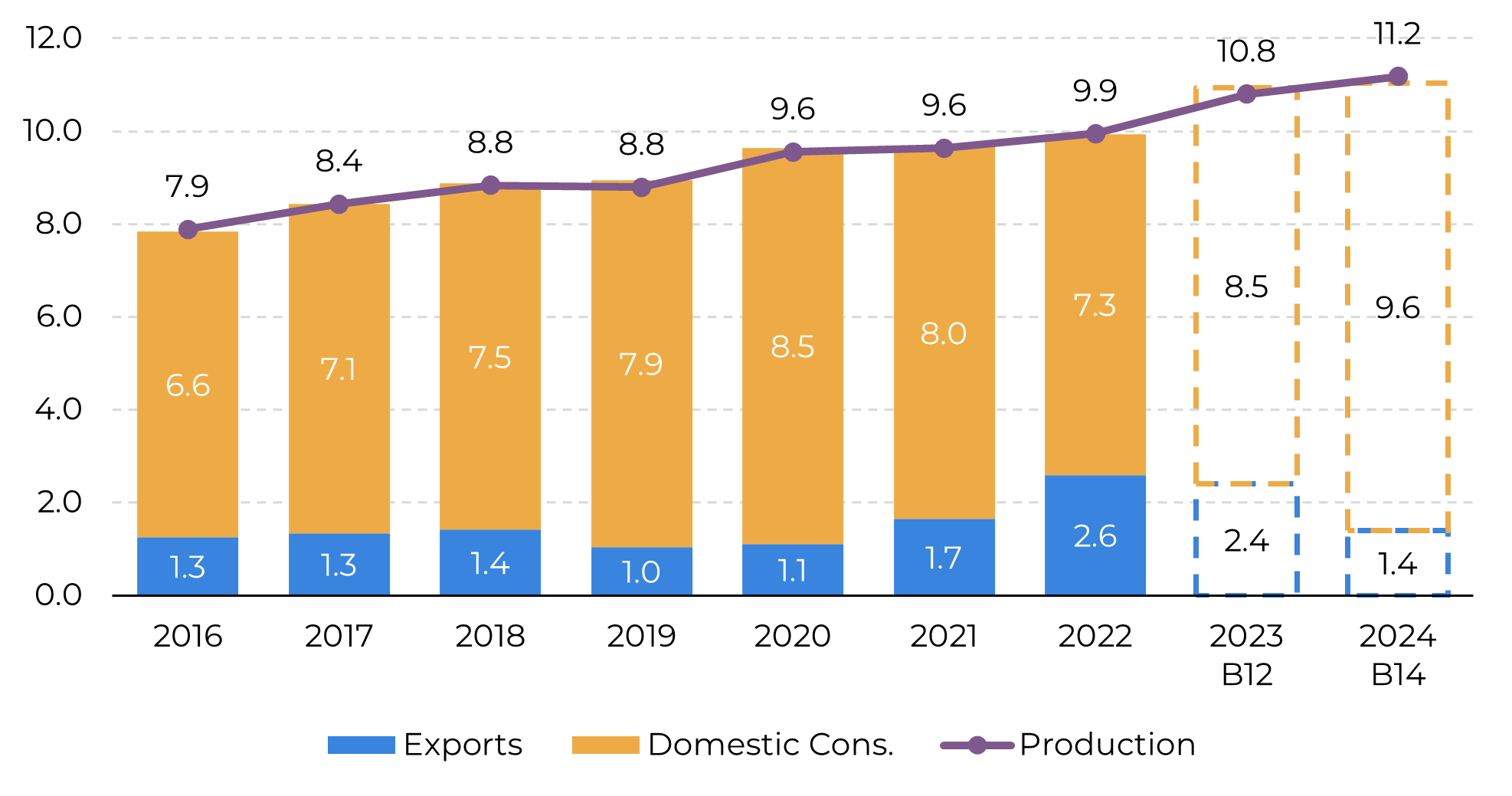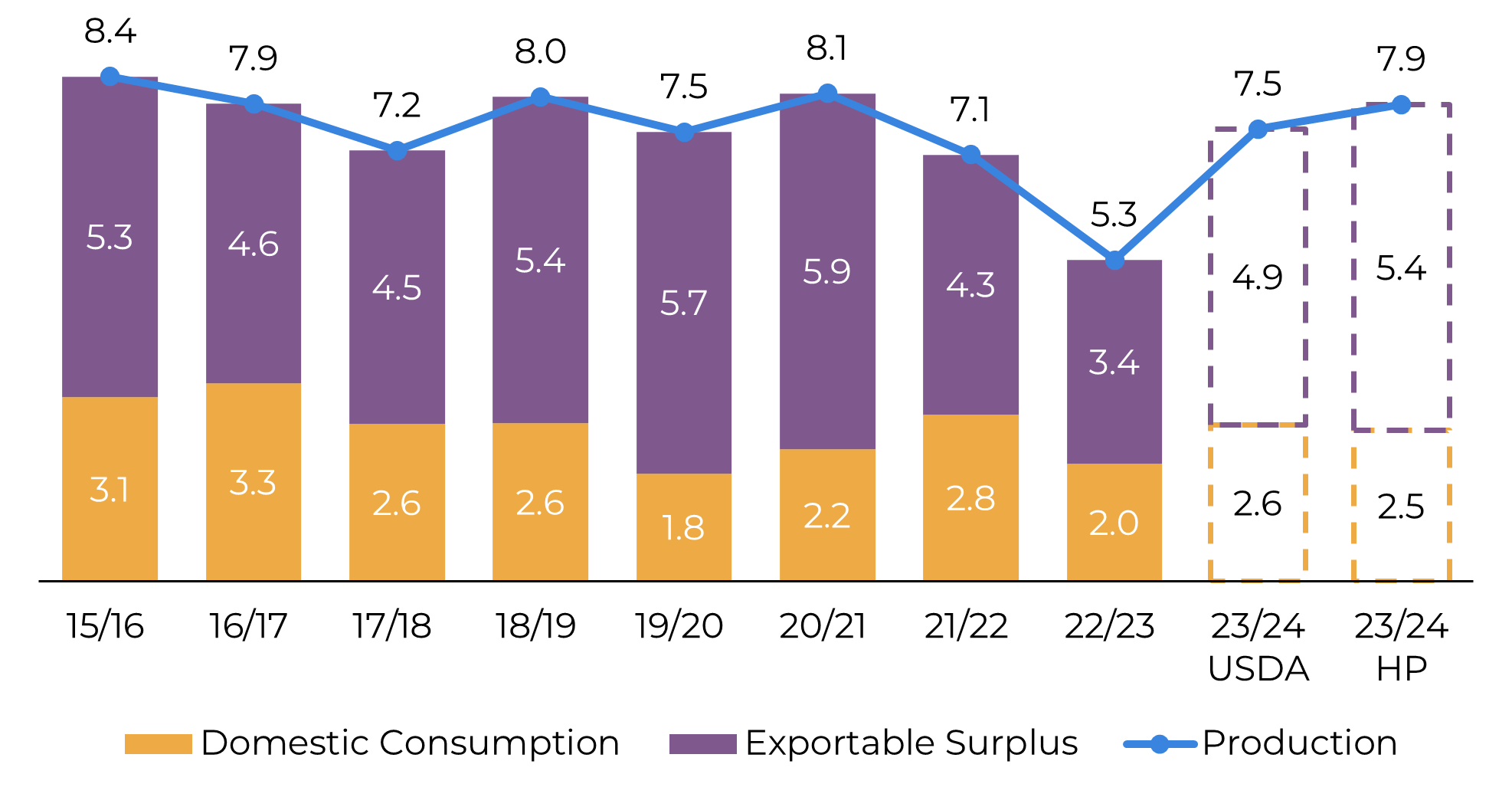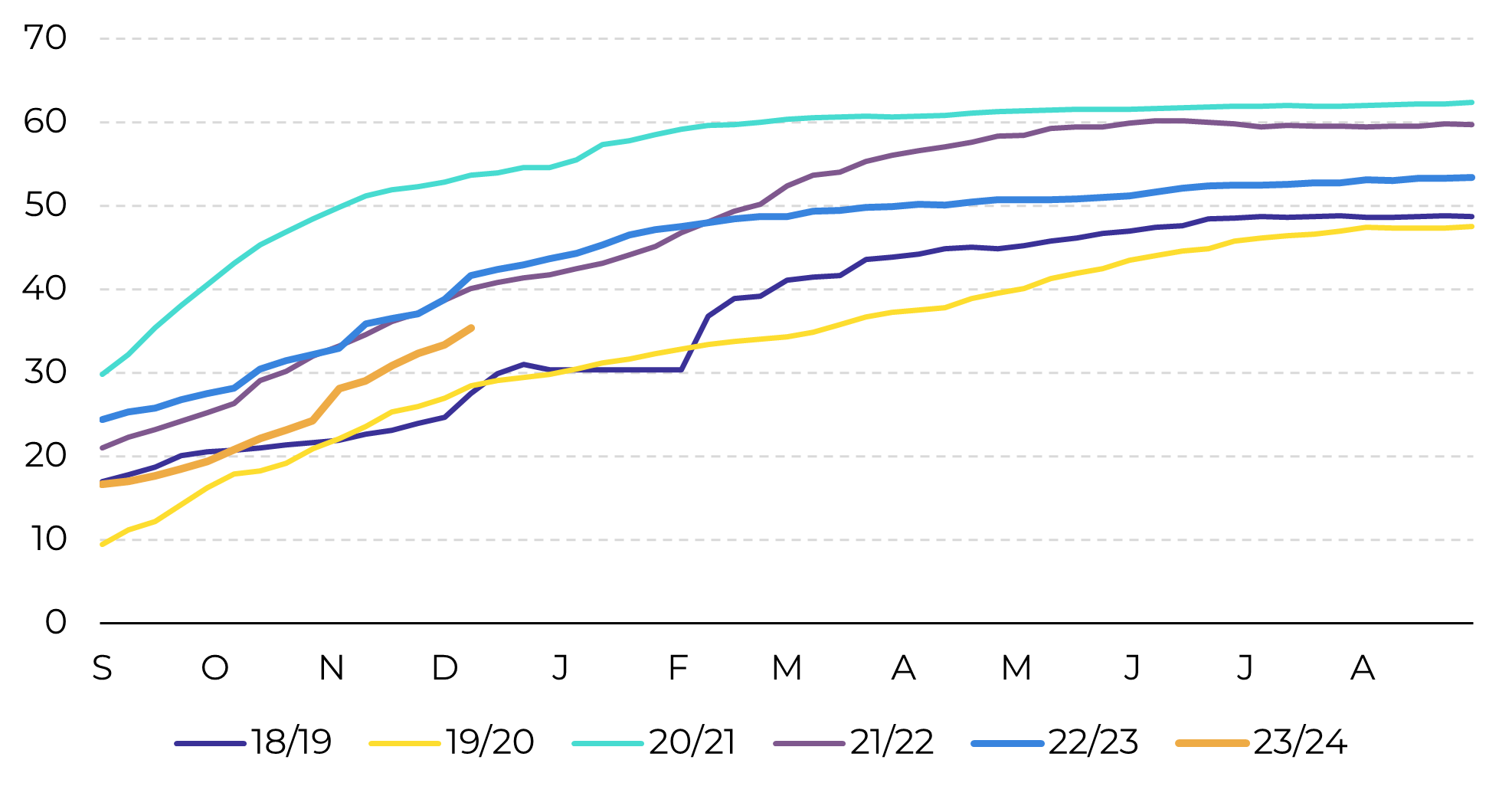
Dec 26
/
Pedro Schicchi
Grains, Oilseeds and Livestock Weekly Report - 2023 12 26
Back to main blog page
Recent estimates indicate a reduction in the expectation of soybean production in Brazil, due to unfavorable weather conditions.
The increase in the biodiesel mandate in Brazil can drive domestic demand for soybeans. However, the return of Argentina can reduce soy oil exports, offsetting part of this effect.
Projections suggest a moderate increase in total oil demand, resulting in a growth of 1-2M tons in soybean crushing.
The Chicago market, which was sensitive to Brazilian weather conditions, has been ignoring a bit the recent developments. US exports and Argentine production in 2024 are the main factors behind this behavior.
Soybean Complex: Brazil, Argentina and Chicago
Introduction
Until a few weeks ago, the average private estimates for soybean production in Brazil hovered around 160 million tons. In recent days, we have seen increasingly lower figures being published, and this average is likely around ~156 million tons today. Our official number, revised in the first half of the month, is 160 million, but there is a prospect of a decrease in the next revision given the observed weather conditions.
Although much lower than the initial crop estimates, these numbers are still close to the harvested quantity in 22/23 – ranging around 155-160 million depending on the source. Of course, most Brazilian states will continue going through critical development stages until the end of January. Thus, if poor weather conditions persist, there may be further losses.
Fig. 1: Soybean Brazil – Area, Yield and Production (M ha, ton/ha, M ton)

Source: Refinitiv
On the domestic demand side...
...each percentage point increase in biodiesel blending represents an additional consumption of ~410K tons of soybean oil, given current diesel consumption levels in Brazil and the historical proportion of soy oil use.
Assuming diesel demand growth, in addition to the announced increase from B12 to B14, as per recent news, there would be an addition of approximately 1.1M ton of soy oil to Brazilian demand. This would translate to approximately 5.5M ton more of soybean crush needed, all else equal (domestic consumption and oil exports).
However, a crucial factor to consider will be the intensity of the reduction in oil exports. With good production in Argentina, the largest exporter of the commodity, we may see a significant reduction in this line of the balance.
Currently, we estimate this cut between 0.8-1.0M ton YoY, but it could be even higher. Taking both factors into account, we would be looking at a more moderate increase in total oil demand, something between 0.2 to 0.4M ton more than in 2023. When translated to soybeans, this gives us a growth of 1-2M ton in crushing.
Currently, we estimate this cut between 0.8-1.0M ton YoY, but it could be even higher. Taking both factors into account, we would be looking at a more moderate increase in total oil demand, something between 0.2 to 0.4M ton more than in 2023. When translated to soybeans, this gives us a growth of 1-2M ton in crushing.
On the other hand, domestic demand for soybean meal has been growing at lower rates than for oil, and therefore, there is an increasing surplus of It in Brazil. In 2023, the country was able to export significant volumes due to the lack of Argentine meal.
However, in 2024, Brazil will likely need to continue increasing crushing to meet the soy oil demand, but the "excess" of meal produced may not find such warm demand due to increased competition with Argentina.
Fig. 2: Soybean Oil Brazil – Supply and Demand (M ton)

Source: CME, NYMEX
Fig. 3: Soybean Oil Argentina – Supply and Demand (M ton)

Source: EPA
But what about Chicago?
As mentioned in previous reports, Chicago had been more sensitive to the Brazilian weather market than usual due to the tight soy balance in the US. Thus, lower production in Brazil would mean lower exports in the country and therefore, higher demand for the US.
Also mentioned in last week's report, futures at CBOT gave back some of the gains observed between October and November. This would make them more prone to an upward movement. However, over the week, there were lower production estimates, and Chicago was still down. Why?
There are two factors to consider, and they have opposite effects on prices.
The first – and more direct – is that the lower Brazilian production only affects the American balance if exports increase in the US, which has not happened on a larger scale yet, but may begin to happen soon.
The first – and more direct – is that the lower Brazilian production only affects the American balance if exports increase in the US, which has not happened on a larger scale yet, but may begin to happen soon.
The second is that Argentina may add spice to this mix. With a much better production volume in 23/24, the country can export more soybeans, contrary to its usual profile of selling by-products. This factor is only strengthened by recent news of the equalization of the soybean complex export tax, which increases the competitive advantage of the exporter versus the industry.
In summary, there are still elements for the reduction in the Brazilian crop to have bullish effects on Chicago prices, but attention should be paid to Argentina, which will play a crucial role in 2024.
Fig. 4: Soybean US – Export Sales (M ton)

Source: CME, NYMEX
Fig. 5: Soybean CBOT – Futures for January and March 2024 (USDc/bu)

Source: EPA
In summary
We believe in good production out of South America in 23/24 and, therefore, in lower prices in general. Still, a combination of market factors could add some support to both corn and soybean prices in the short term.
Weekly Report — Grains and Oilseeds
Written by Pedro Schicchi
pedro.schicchi@hedgepointglobal.com
Reviewed by Alef Dias
alef.dias@hedgepointglobal.com
alef.dias@hedgepointglobal.com
www.hedgepointglobal.com
Disclaimer
This document has been prepared by hEDGEpoint Global Markets LLC and its affiliates ("HPGM") exclusively for informational and instructional purposes, without the purpose of creating obligations or commitments with third parties, and is not intended to promote an offer, or solicitation of an offer, to sell or buy any securities or investment products. HPGM and its associates expressly disclaim any use of the information contained herein that may result in direct or indirect damage of any kind. If you have any questions that are not resolved in the first instance of contact with the client (client.services@hedgepointglobal.com), please contact our internal ombudsman channel (ouvidoria@hedgepointglobal.com) or 0800-878-8408 (for clients in Brazil only).
Contact us
hedgepointhub.support@hedgepointglobal.com
ouvidoria@hedgepointglobal.com
Funchal Street, 418, 18º floor - Vila Olímpia São Paulo, SP, Brasil
Check our general terms and important notices.
This page has been prepared by Hedgepoint Schweiz AG and its affiliates (“Hedgepoint”) solely for informational and instructional purposes, without the purpose of instituting obligations or commitments to third parties, nor is it intended to promote an offer, or solicitation of an offer of sale or purchase relating to any securities, commodities interests or investment products. Hedgepoint and its associates expressly disclaim any use of the information contained herein that directly or indirectly result in damages or damages of any kind. Information is obtained from sources which we believe to be reliable, but we do not warrant or guarantee the timeliness or accuracy of this information. The trading of commodities interests such as futures, options, and swaps involves substantial risk of loss and may not be suitable for all investors. You should carefully consider wither such trading is suitable for you in light of your financial condition. Past performance is not necessarily indicative of future results. Customers should rely on their own independent judgement and/or advisors before entering in any transaction.Hedgepoint does not provide legal, tax or accounting advice and you are responsible for seeking any such advice separately.Hedgepoint Schweiz AG is organized, incorporated, and existing under the laws of Switzerland, is filiated to ARIF, the Association Romande des Intermédiaires Financiers, which is a FINMA-authorized Self-Regulatory Organization. Hedgepoint Commodities LLC is organized, incorporated, and existing under the laws of the USA, and is authorized and regulated by the Commodity Futures Trading Commission (CFTC) and a member of the National Futures Association (NFA) to act as an Introducing Broker and Commodity Trading Advisor. HedgePoint Global Markets Limited is Regulated by the Dubai Financial Services Authority. The content is directed at Professional Clients and not Retail Clients. Hedgepoint Global Markets PTE. Ltd is organized, incorporated, and existing under the laws of Singapore, exempted from obtaining a financial services license as per the Second Schedule of the Securities and Futures (Licensing and Conduct of Business) Act, by the Monetary Authority of Singapore (MAS). Hedgepoint Global Markets DTVM Ltda. is authorized and regulated in Brazil by the Central Bank of Brazil (BCB) and the Brazilian Securities Commission (CVM). Hedgepoint Serviços Ltda. is organized, incorporated, and existing under the laws of Brazil. Hedgepoint Global Markets S.A. is organized, incorporated, and existing under the laws of Uruguay. In case of questions not resolved by the first instance of customer contact (client.services@Hedgepointglobal.com), please contact internal ombudsman channel (ombudsman@hedgepointglobal.com – global or ouvidoria@hedgepointglobal.com – Brazil only) or call 0800-8788408 (Brazil only).Integrity, ethics, and transparency are values that guide our culture. To further strengthen our practices, Hedgepoint has a whistleblower channel for employees and third-parties by e-mail ethicline@hedgepointglobal.com or forms Ethic Line – Hedgepoint Global Markets.Security note: All contacts with customers and partners are conducted exclusively through our domain @hedgepointglobal.com. Do not accept any information, bills, statements or requests from different domains and pay special attention to any variations in letters or spelling, as they may indicate a fraudulent situation.“HedgePoint” and the “HedgePoint” logo are marks for the exclusive use of HedgePoint and/or its affiliates. Use or reproduction is prohibited, unless expressly authorized by HedgePoint. Furthermore, the use of any other marks in this document has been authorized for identification purposes only. It does not, therefore, imply any rights of HedgePoint in these marks or imply endorsement, association or seal by the owners of these marks with HedgePoint or its affiliates.
We have updated our Terms & Conditions to reflect improvements to our platform, data handling practices, and the overall experience we provide to our clients.
To continue using the Hedgepoint HUB, please review and accept the updated terms.

